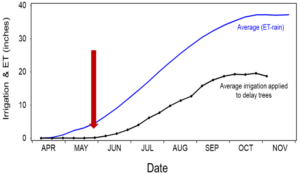Curt Pierce, UCCE Irrigation and Water Resource Advisor
Luke Milliron, UCCE Orchard Systems Advisor
With the days only just warming and (at the time of this writing) significant rain still falling in the North Sacramento Valley, few are likely to be in any rush to start pumping. Spring heat can come on fast, however, quickly drying the soil surface and raising questions about when to best start replacing “lost” soil moisture with regular irrigations. UC continually researches and updates the recommended best practices for spring walnut irrigation to ensure the healthiest orchards possible and help lower utility costs. This research has shown that, by delaying the start of regular irrigations, it might be possible to irrigate as little as one-half of what was previously thought to be needed, with little to no impact on production (Figure 1).

Figure 1: Summary of average orchard water requirement (ET minus rain) and applied irrigation for all delayed irrigation tests to date (2014 – 2020). Averaged over all sites and years thus far, the delay period has been almost two months (indicated by arrow) compared to the start of ET. The total water applied to the delay trees has only been about 50% of the orchard ET need (ET-rain).
We know that walnut is more sensitive to water stress than some other tree crops, but what does that mean? When many folks think of water stress, they think of the stress to the tree that comes from too little water, as in times of drought or extreme heat. Of course, water stress can, and often does, come from too much water as well. We often see this play out at the tail ends of the wet season, with walnut orchards underwater for extended periods just as they emerge from dormancy in spring.
While the primary concern from these events may be disease, such as Phytophthora, when the water is not actively flowing, waterlogging of the roots can result from the lack of oxygenation in the water. However, water stress in the root zone isn’t confined to extreme flood events. The most active growth period for new roots, those best able to uptake water and nutrients, is in spring and early summer. As they grow into new soil, these roots form the scaffolding for additional root growth throughout the growing season. Too much soil water early in the spring can suppress the most significant growth of these roots – limiting water and nutrient uptake potential during the hottest and driest weeks of summer, as well as causing tip burn, leaf damage, and dark kernels. When compared to other area tree crops, walnut is simply more sensitive to water stress, and therefore more difficult to irrigate “just right.”
Effectively managing irrigation in walnut, including when to start, is easiest when employing the pressure chamber, which measures one indicator of the tree’s “stress level” – the stem water potential (SWP). While there are countless differences between operations, the economics of owning a pressure chamber can quickly pencil-out whether owning one outright, cost-sharing on a unit with others, or adding it to the list of services from your PCA. Savings on power bills from $50-$100 per acre can be reasonably expected with effective, plant-based irrigation management, such as with SWP monitoring.
UC has developed a table of baseline values (included with this issue) that can be used together with a pressure chamber to help determine when best to irrigate. Continuing research done by UC has shown that waiting until walnut trees show a SWP value with the pressure chamber that is slightly drier (2-3 bars drier or more negative) than the fully irrigated “baseline” SWP value. Of course, your local UCCE advisors are here to help if you do not have access to a pressure chamber or other means to determine SWP in your orchard. We can also help with equipment and scheduling training for those of you who have access to a pressure chamber but are not comfortable using it for irrigation scheduling.
Beyond the pressure chamber? Despite showing that it provides a great return on investment, we know some growers struggle to get on board with the pressure chamber. Whether it’s the cost of purchasing one or the skilled labor at midday required for its use. Researchers at UC Davis have conducted preliminary field tests in 2024 using an optical dendrometer that showed a high correlation with the pressure chamber. However, these are early days in that research, and we don’t yet have a silver bullet solution for automated plant water stress monitoring in walnut. For now, the pressure chamber remains the only way to reliably irrigate to the plant’s needs in walnut.


Leave a Reply